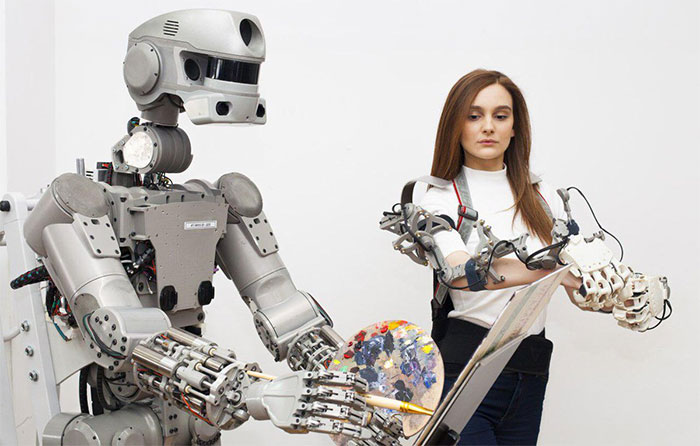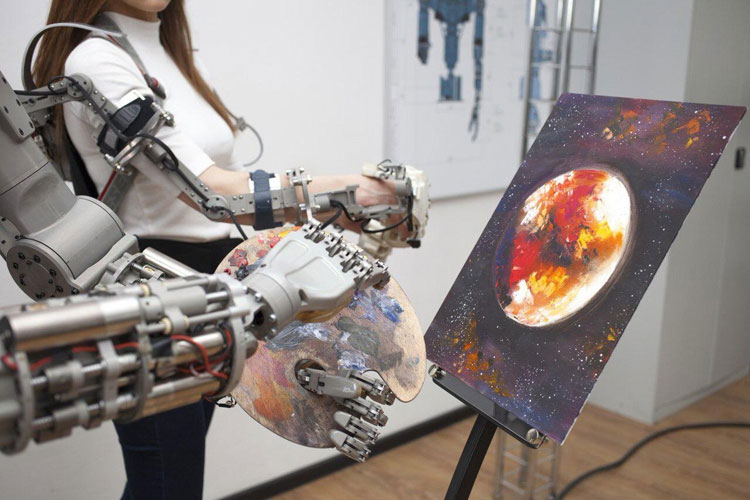Russia shows off space robots superior to the US and China
Sputnik Information, Roscosmos and Energia Space Rocket Corporation have just received a humanoid robot called FedOR (Researching the Final Test Object) to use the potential in manned space missions.

Robot FedOR practices fine motor skills.(Photo: Twitter Dmitry Rogozin).
The head of Roscosmos Dmitry Rogozin wrote on personal Twitter page: " FedOR - humanoid rescue robot developed by Android Technology R&D Company as well as Russia's Advanced Research Project Fund - has been handed over to Roscosmos and RSC Energia to study the opportunity to use it in manned space missions, now robots are learning fine motor skills.
Last year, a source in the Russian space and rocket industry revealed that Roscosmos wanted to send two robots to the International Space Station (ISS) in 2019 on a Soyuz-MS unmanned spacecraft. The flight is scheduled for August 22, 2019.
FedOR will also be used on the new spacecraft Federatsiya, scheduled for 2022.
This ship is designed to bring up to 4 people and cargo to the Moon and space stations on Earth's low orbit.
The automatic flight time of the Federatsiya spacecraft is estimated to be up to 30 days, with the possibility of being attached to a space station for up to a year.

FedOR robot, but Director Roscosmoss received a reply.(Photo: Twitter Dmitry Rogozin).
Although Dmitry Rogozin wrote on Twitter personally expressed the joy of receiving a robot that can perform space missions. However, his readers are not so excited. FedOR photo shows clearly that it is not a robot installed artificial intelligence. It is only performing operations according to an instructor.
Besides, if the robot is functioning as a pilot on an unmanned spaceship, it is too redundant because it is possible to use autopilot technology to do this.

FedOR is not an independent robot, but a manipulation model?
Another reader is interested in the authenticity of the photo. It seems that the palm that FedOR robot is holding is too clean for a finished picture. In addition, the color palette is almost not the same as the colors on the picture.

Robot FedOR is soon put into space.(Photo: Twitter Dmitry Rogozin).
These observations suggest that Russia's FedOR is not really considered an independent robot. Therefore, it is hard to believe that FedOR will be able to carry out a space mission and this is a waste of money.
If you develop a robot to demonstrate the robot race with the US and China, Russia will surely lose.
FedOR has previously been introduced to perform a series of experiments that can perform dangerous tasks outside of the Moon.

FedOR is able to work with high precision, can weld electronic circuits.
Fedor astronaut robots can walk for hours, lift heavy objects, stand up after falling, even drive proficiently according to human remote control or operate automatically.
FedOR also has the ability to work with high precision, can weld electronic circuits. In the future, it will have enough intelligence and computing power to do many different things completely automatically.
The FedOR robot is expected to replace astronauts who do dangerous tasks outside the ISS station, not just pilots on an unmanned ship.
Before Russia announced its plan to put FedOR robots into space, China has successfully launched the first probe to bring the Rabbit Ngoc self-propelled robot to the Moon. The West has suspected that this is China's new military ambition.
Meanwhile, the US also has its own self-propelled robot brought to the Moon with the task of excavating hydrogen, oxygen and freezing water from the rock pillars standing on the surface of this planet's satellite. But in 5/2018, decided to cancel the Resource Prospector program to bring the robot to the Moon, which surprised many scientists.
- 10 robots with animal shapes
- Waiter in China
- Russia - China cooperates to explore the Moon
- Russia and China cooperated to explore Mars
- Russia takes astronaut robots into space
- China launches automatic parking with robots
- 'Ghost robots' know how to dive, fly and climb all terrain
- Russia and China cooperate to study the moon
- Robot doctor in space
- China will soon surpass Russia in the number of satellites operating in orbit
- China is about to
- Robot lizards - equipment dedicated to the universe in the future
 Van Allen's belt and evidence that the Apollo 11 mission to the Moon was myth
Van Allen's belt and evidence that the Apollo 11 mission to the Moon was myth The levels of civilization in the universe (Kardashev scale)
The levels of civilization in the universe (Kardashev scale) Today Mars, the sun and the Earth are aligned
Today Mars, the sun and the Earth are aligned The Amazon owner announced a secret plan to build a space base for thousands of people
The Amazon owner announced a secret plan to build a space base for thousands of people